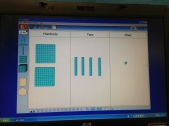We began a new math unit in first grade, introducing the concept of place value. This is an important concept for students to comprehend and explain to build number sense, but it is also challenging. We began using base-ten blocks to make place value as visual as possible. Using the blocks and trading really helped students begin understanding the concept of tens and ones. They had some more difficulty with trading when there were more than ten ones, but with more practice, wheels began turning and slowly students started getting it.
In the computer lab, we used Kidspiration to give students additional practice to build numbers using base-ten blocks. After modeling, students were given the opportunity to build two or three digit number and write a number sentence explaining how they knew it was that number. Students were excited to explore and create numbers, and they enjoyed sharing their creations with classmates and me.
In addition to building numbers and making sure they understood the place value concept, it was also amazing watching students make discoveries about Kidspiration features that helped them increase their understanding. First, students discovered they could change colors of the blocks, which was just fun.
Then, one student found a button to make a hundreds, tens, ones chart to organize where the different blocks go based on their value; another student then discovered if you clicked the button again, you create the same chart with the thousands place.
Near the end of lab time, a final student discovered a button to break apart the blocks so you could see how each level is built on the previous ones. I thought this was great because students could see 100 ones and 10 tens was the same as 1 hundred.
It was even better that students were curious and engaged to try features and made discoveries that increased their understanding of a difficult concept. This was an example of authentic learning and the power of student discovery!






Leave a comment